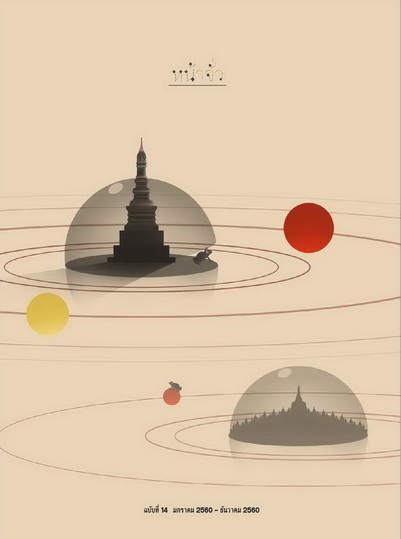ผังเมืองสุโขทัยและวัฒนธรรมการปลูกตาล/ Historic Town of Sukhothai and Cultural Aspects of Its Toddy Palm Trees
Main Article Content
Abstract
บทคัดย่อ
ลักษณะผังเมืองโบราณสุโขทัยประมวลได้จากจารึกพ่อขุนรามคำแหงอายุ พ.ศ. 1835 ที่เมื่อแรกสร้างรับอิทธิพลทั้งจากเขมรและมอญ ผังเมืองโบราณสุโขทัยที่สร้างในสมัยพ่อขุนศรีนาวนำถม มีลักษณะคล้ายผังเมืองเขมรในxระเทศไทยและในประเทศกัมพูชา กล่าวคือ เป็นผังเมืองรูปสี่เหลี่ยมที่มีกำแพงและคูน้ำล้อมรอบ ภายในเมืองและนอกเมืองมีสระน้ำรูปสี่เหลี่ยมเพื่อการอุปโภคและบริโภค รวมทั้งมีอ่างกักเก็บน้ำตั้งอยู่นอกเมืองเพื่อการชลประทานในการทำเกษตรกรรม ลักษณะมอญปรากฏที่ตำแหน่งทางเข้าหลักของเมืองสุโขทัยทางทิศเหนือ ซึ่งคล้ายคลึงกับที่ปรากฏ ณ เมืองหริภุญชัยและเชียงใหม่ และกึ่งกลางเมืองเป็นที่ตั้งของพระเจดีย์สำคัญประจำเมือง สุโขทัยยังมีวัฒนธรรมการปลูกตาลคล้ายกับสุพรรณบุรี ราชบุรี เพชรบุรี และนครศรีธรรมราช รวมทั้งพุกามในประเทศพม่า คนพม่าที่พุกามนิยมถวายสวนตาลให้กับวัดและพระเจดีย์ เพราะต้นตาลเป็นไม้สารพัดประโยชน์ ใบตาลใช้ทำตาลปัตรและเป็นกระดาษสำหรับจารหนังสือ น้ำตาลปึกใช้เป็นส่วนผสมของยาแพทย์แผนโบราณและปูนตำในงานสถาปัตยกรรม
Abstract
The characteristics of Sukhothai’s historic town in the early stage of its establishment were described in the inscription of King Ramkhamhaeng dated 1292. Sukhothai town planning was probably influenced by the Khmer and Mon. Sukhothai historic town layout established in the reign of Khun Sri Naonumthom resembled Khmer towns in Thailand and Cambodia. They were built in a rectangular shape enclosed with walls and moats and included ponds in a rectangular form for daily used inside and outside the inner town. Furthermore, they had reservoirs for irrigation system outside the inner town. Mon characteristics in Sukhothai were found on the location of the main town gate to the north parallel to those of Hariphunchai and Chiang Mai as well as of the principal pagoda established at the center. People of Sukhothai had a custom to plant toddy palm trees parallel to those of Suphanburi, Ratchaburi, Phetchaburi, and Nakhon Si Thammarat in Thailand as well as to those of Pagan in Burma. The Burmese of Pagan donated toddy palm groves to Buddhist monasteries and pagodas as the trees provided multiple uses. Toddy plam leaves were used to make fans and writing material. Palm jaggery could be a component of traditional medicine and an organic admixture of traditional mortar for architecture.


